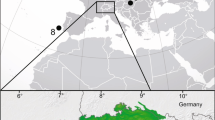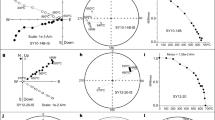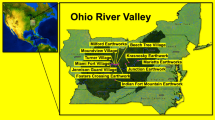Abstract
The most profound climatic event of the Tertiary was the terminal Eocene event at −34 Myr (ref. 1). Botanical data indicate that winters became much more severe, while summer temperatures were little affected. An explanation in terms of a change in the space direction of the Earth's axis is not dynamically acceptable. On the other hand, an ecological disaster of some kind apparently struck the Radiolaria at this time2; the latter event is accurately correlated (to a few tens of thousands of years) with the formation of the greatest known tektite strewn field, the so-called North American strewn field, which has recently been shown to extend at least half-way around the Earth3. It is suggested here that tektites and microtektites which accompanied this fall, but missed the Earth, organized themselves into a ring system like that of Saturn. The shadow of the rings fell on the winter hemisphere and so produced the observed cooling. The ring lasted between one and several million years.
This is a preview of subscription content, access via your institution
Access options
Subscribe to this journal
Receive 51 print issues and online access
$199.00 per year
only $3.90 per issue
Buy this article
- Purchase on Springer Link
- Instant access to full article PDF
Prices may be subject to local taxes which are calculated during checkout
Similar content being viewed by others
References
Wolfe, J. A. Am. Scient. 66, 694–703 (1978).
Glass, B. P. & Zwart, M. J. in Proc. Symp. Stratigraphie Micropaleontology of the Atlantic Basin and Borderlands (ed. Swain, F. W.) 553–567 (Elsevier, New York, 1977).
Glass, B. P., Swincki, M. B. & Zwart, P. A. Lunar planet. Sci. 10, 434–436 (1979).
Darwin, G. H. Scientific Papers Vol. 2, 208–302 (Cambridge University Press, 1908).
Brosche, P. & Sündermann, J. (eds) Tidal Friction and the Earth's Rotation (Springer, New York, 1978).
Urey, H. C. Nature 242, 32–33 (1973).
O'Keefe, J. A. Tektites and their Origin, 180–187 (Elsevier, New York, 1976).
Jeffreys, H. Mon. Not. R. astr. Soc. 107, 263–267 (1947).
Brahic, A. Astr. Astrophys. 54, 895–907 (1977).
Glass, B. P. & Zwart, M. J. Bull. geol. Soc. Am. 90, 595–602 (1979).
Goldreich, P. & Tremaine, S. Icarus 34, 240–253 (1978).
Opp, A. G. Science 207, 401–403 (1980).
Comstock, G. M. Lunar Science VIII, 202–204 (Lunar Science Institute, Houston, 1977).
Paddack, S. J. J. geophys. Res. 74, 4379–4381 (1969).
Jacchia, L. in The Moon, Meteorites and Comets (eds Middlehurst, B. M. & Kuiper, G. P.) 783–784 (University of Chicago Press, Chicago, 1963).
Ruderman, M. & Truran, J. W. Nature 284, 328–329 (1980).
Author information
Authors and Affiliations
Rights and permissions
About this article
Cite this article
O'Keefe, J. The terminal Eocene event: formation of a ring system around the Earth?. Nature 285, 309–311 (1980). https://doi.org/10.1038/285309a0
Received:
Accepted:
Issue Date:
DOI: https://doi.org/10.1038/285309a0
This article is cited by
-
Spore–pollen evidence for early Oligocene high-latitude cool climatic episode in northern Canada
Nature (1982)
-
On the secular decrease in the semimajor axis of Lageos's orbit
Celestial Mechanics (1982)
-
Climate and paleoclimate: What we can learn about solar luminosity variations
Solar Physics (1981)
-
Late Eocene rings around the Earth?
Nature (1980)
Comments
By submitting a comment you agree to abide by our Terms and Community Guidelines. If you find something abusive or that does not comply with our terms or guidelines please flag it as inappropriate.



